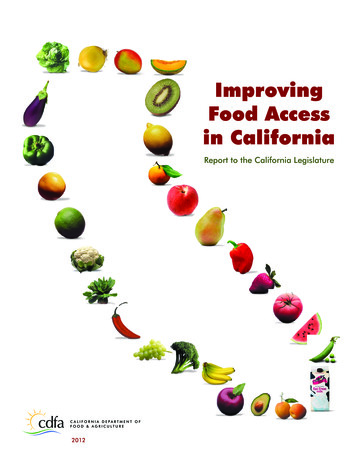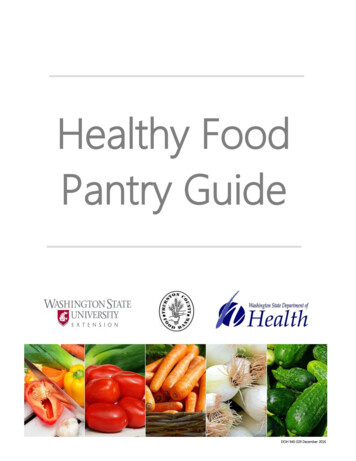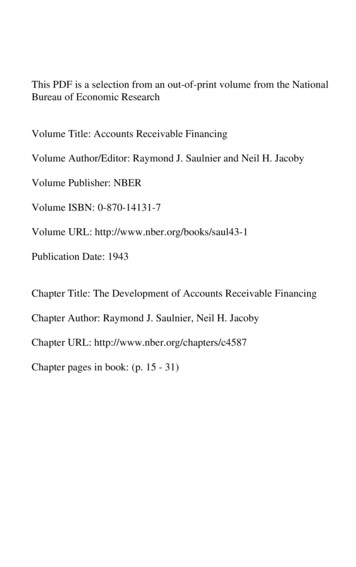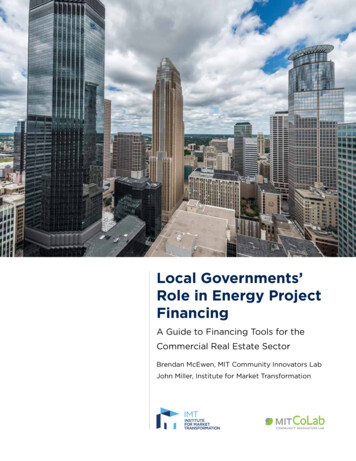
Transcription
America’s Healthy Food Financing InitiativeTargeted Small Grants Program2020 Request for Applications (RFA)1
Reinvestment FundAmerica’s Healthy Food Financing InitiativeTargeted Small Grants Program2020 Request for Applications (RFA)FUNDING OPPORTUNITY TITLEAmerica’s Healthy Food Financing Initiative Targeted Small Grants Program (HFFI TSG Program)ANNOUNCEMENT TYPEInitialCATALOG OF FEDERAL DOMESTIC ASSISTANCE (CFDA) NUMBER10.872EXECUTIVE SUMMARYReinvestment Fund, in its capacity as National Fund Manager for the Healthy Food Financing Initiative atUSDA Rural Business-Cooperative Service, requests applications for America’s Healthy Food FinancingInitiative Targeted Small Grants Program (HFFI TSG Program) for 2020. The amount available for grants in2020 is 3,000,000. The purpose of the program is to improve access to healthy foods in underserved areas,to create and preserve quality jobs, and to revitalize low-income communities. Eligible applicants include forprofit, nonprofit, and cooperatively owned businesses, institutions of higher education, state and localgovernments and tribal governments. Applicants may include food retailers or non-retail food enterprises.Grants will be available to eligible organizations in eligible underserved areas to implement a project that isdesigned to improve access to fresh, healthy food through food retail. While the HFFI TSG Program isdesigned to support projects that respond to food access and food enterprise needs that were evolving priorto the COVID-19 outbreak, we recognize the impact that the COVID-19 pandemic is having on communities,retail outlets, and the food supply chain. Applicants may use their discretion to propose a project that is or isnot related to recovery from the pandemic, directly or indirectly.Technical assistance (TA) will be available for eligible organizations that are in a planning phase or early stageof a food enterprise (including retail) project, and where TA expert guidance would further clarify andadvance a project that supports HFFI goals and priorities. Applicants interested in TA and not grant fundingshould contact Reinvestment Fund for more information on how to receive TA, and read more about TAprograms at ce/This notice identifies the objectives for HFFI TSG Program, deadline dates, funding information,eligibility criteria for projects and applicants, and application requirements and associated instructionsneeded to apply for an HFFI TSG Program grant.DATESLetters of Interest (LOIs) must be received by 8:00 pm Eastern Time on July 10, 2020.Eligible applicants will be invited to submit a full application. Applications will be due 45 days after invitationsare sent.2
WEBINARA webinar will be held for potential applicants at 2:00 pm Eastern Time on June 2, 2020. No registration isrequired. To join the webinar, go to: https://bit.ly/WebinarJune2 at 2:00 pm Eastern Time on June 2, 2020.Reinvestment Fund will record and post the webinar, as well as answers to questions asked during thewebinar, at www.investinginfood.com.FOR FURTHER INFORMATION CONTACT:Program Contact: Molly Hartman, Program Director, Healthy Food Financing InitiativeWebsite: www.investinginfood.comEmail: help@investinginfood.comPhone: 215-574-5862 (Please leave a voicemail if the phone line isn’t answered. Someone willrespond to your inquiry as soon as possible).Address:Reinvestment FundAttn: Healthy Food Financing Initiative1700 Market Street, 19th FloorPhiladelphia, PA 191033
REINVESTMENT FUNDAmerica’s Healthy Food Financing InitiativeTargeted Small Grants Program2020 Request for Applications (RFA)Table of ContentsPART I—FUNDING OPPORTUNITY DESCRIPTION . 5Legislative Authority and Background . 5Program Description . 5Definitions . 6PART II—GRANT AND ELIGIBILITY INFORMATION . 8Available Grants . 8Eligibility . 8What We Will Fund . 9What We Will Not Fund . 11Technical Assistance . 11PART III—APPLICATION PROCESSS AND TIMELINE . 12Phase 1: Letter of Interest (LOI) . 12Phase 2: Application. 12PART IV—SUBMITTING A LETTER OF INTEREST (LOI) AND APPLICATION . 13Applicant Requirements . 13Letter of Interest (LOI) Requirements. 14Application Requirements . 15Other Application Guidelines and Funding Restrictions . 18PART V—APPLICATION REVIEW . 19PART VI—GRANT AWARD ADMINISTRATION . 21PART VII—HFFI PROGRAM CONTACT . 234
PART I—FUNDING OPPORTUNITY DESCRIPTIONLegislative Authority and BackgroundThis program is authorized under the Agriculture Act of 2014 (P.L. 113-79), Section 4206 - Healthy FoodFinancing Initiative (HFFI) and reauthorized under the Agriculture Act of 2018 (P.L. 115-334), Section 4204.The purpose of HFFI is to improve access to healthy foods in underserved areas, to create and preservequality jobs, and to revitalize low-income communities by providing loans and grants to eligible fresh, healthyfood retailers and enterprises to overcome the higher costs and initial barriers to entry in underserved areas.All Americans deserve access to fresh, healthy, and affordable food. Research indicates that when peoplehave local access to fresh food, they make healthier choices about their diets, have better health outcomes,and benefit from improved local economic development. Equitable access to healthy food is enabled by afood system where enterprises across the food supply chain can thrive and deliver fresh, healthy, andaffordable products. The COVID-19 pandemic has revealed how essential grocery stores, food suppliers, andtheir employees are to communities. The economic impact of the pandemic will only further constrain lowincome families’ ability to afford and access healthy food. The goal of the Healthy Food Financing Initiative isto address this critical issue by investing in food retail and food enterprises throughout the food system thatcontribute to improved fresh food retail access in low-income and underserved communities across thecountry.HFFI is administered by a National Fund Manager. In 2017, Reinvestment Fund was appointed to serve as theNational Fund Manager (NFM) for HFFI at USDA. As the NFM for HFFI, Reinvestment Fund will leverageprivate capital, provide financial and technical assistance to regional, state and local partnerships, andchannel capital to fund eligible projects that will improve access to fresh, healthy foods in underserved ruraland urban areas.Reinvestment Fund is a national mission-driven financial institution that creates opportunity for underservedpeople and places through partnerships. We marshal the capital, analytics, and expertise necessary to buildstrong, healthy, and more equitable communities. Headquartered in Philadelphia, Reinvestment Fund has put 2.3 billion in cumulative lending and investments to work for communities across the country since 1985.Beginning with the Pennsylvania Fresh Food Financing Initiative (FFFI) in 2004, we have developed acomprehensive and evidence-based approach to improving the food landscape for low-income people. Sincethat time, we have provided more than 300 million in grants and loans to healthy food projects.Reinvestment Fund also founded and manages ReFresh, a capacity-building initiative that is composed ofCDFI partners across the country, who are among the largest national practitioners in healthy food financing.Program DescriptionThe purpose of America’s Healthy Food Financing Initiative (HFFI) is to improve access to healthy food inunderserved areas, to create and preserve quality jobs, and to revitalize low-income communities byproviding financial and technical assistance to eligible fresh, healthy food retailers and enterprises toovercome the higher costs and initial barriers to entry in underserved areas. HFFI will offer fundingopportunities and technical assistance to eligible applicants.This Request for Applications (RFA) is for a Targeted Small Grants (TSG) program. The TSG program offersfinancial assistance in the form of grants to eligible fresh, healthy food retailers and enterprises.5
The TSG program supports innovative fresh food retail and food system enterprises that seek to improveaccess to healthy food in underserved areas through food retail. Grants could assist projects with a variety ofaspects of project development, renovation, and/or expansion. Grants are designed to be one-timeinvestments of capital into a food retail or food enterprise project in order to address higher costs and initialbarriers to entry in underserved rural and urban areas. Grant funds should unlock additional sources ofcapital, catalyze project sustainability, meet financing gaps, and/or enable deeper impact or project reach.In conjunction with the TSG program, Reinvestment Fund will also provide Technical Assistance (TA) tosupport selected early stage projects where resources would help build local capacity to develop a food retailoutlet or enterprise and would clarify or advance an eligible project.DefinitionsCOMMUNITY FOOD ASSESSMENT: A collaborative and participatory process that systematically examines abroad range of community food issues and assets, so as to inform change actions to make the communitymore food secure.FOOD ENTERPRISES: “Food Enterprises” are businesses or organizations along the food supply chain such asfood hubs; food producers, distributors, processors, and manufacturers; commercial kitchens and foodbusiness incubators; mobile markets; and other direct to consumer markets. Food Enterprises do notnecessarily involve the direct sale of food to consumersHEALTHY FOOD(S): The term “Healthy Food(s)” will have the same meaning as used by the CDFI Fund—nutrient-dense foods and beverages as set forth in the USDA Dietary Guidelines for Americans 2015-2020including whole fruits and vegetables, whole grains, fat free or low-fat dairy foods, lean meats andpoultry (fresh, refrigerated, frozen or canned). Healthy Foods should have low or no added sugars, and below-sodium, reduced sodium, or no-salt-added. (See USDA Dietary idelines).LOW-INCOME COMMUNITIES: As defined by the CDFI Fund under the 2018 CDFI Program, the term “LowIncome” means income, adjusted for family size, of not more than:1) For Metropolitan Areas, 80 percent of the area median family income; and2) For non-Metropolitan Areas, the greater of:i.80 percent of the area median family income; orii.80 percent of the statewide non-Metropolitan Area median family incomeMODERATE INCOME COMMUNITIES: As defined by the CDFI Fund under the 2018 CDFI Program, the term“Moderate Income” means income, adjusted for family size, of not more than:1) For Metropolitan Areas, 120 percent of the area median family income; and2) For non-Metropolitan Areas, the greater of:i.120 percent of the area median family income; orii.120 percent of the statewide non-Metropolitan Area median family incomeNATIONAL FUND MANAGER (NFM): Per 7 U.S.C. § 6954(b)(3): The term “National Fund Manager” means acommunity development financial institution that is –(A) in existence on the date of enactment of this section; and(B) certified by the Community Development Financial Institution Fund of the Department of Treasury tomanage the Initiative for purposes of:i.raising private capital;ii.providing financial and technical assistance to partnerships; and6
iii.funding eligible projects to attract fresh, healthy food retailers to underserved areas, inaccordance with this section.PERISHABLE FOOD: As defined in Section 4206 of the Agricultural Act of 2014, the term “Perishable Food”means a staple food that is fresh, refrigerated, or frozen.QUALITY JOB: As defined in Section 4206 of the Agricultural Act of 2014, the term “Quality Job” means a jobthat provides wages and other benefits comparable to, or better than, similar positions in existingbusinesses of similar size in similar local economies.RETAIL OUTLETS: A retail outlet that accepts benefits under the supplemental nutrition assistance programestablished under the Food and Nutrition Act of 2008 (7 USC 2011 et. Seq.)RURAL AREA: The term “Rural Area” means the Rural Business Service’s rural area definition as outlined inSection 343(a)(13)(A)(i) of the Consolidated Farm and Rural Development Act which states: any areaother than: (1) A city or town that has a population of greater than 50,000 inhabitants; and (2) anyurbanized area contiguous and adjacent to such a city or town.STAPLE FOOD: As defined in Section 4206 of the Agricultural Act of 2014, the term “Staple Food” means foodthat is a basic dietary item, which includes bread, flour; fruits; vegetables; and meat.SUPPLEMENTAL NUTRITION ASSISTANCE PROGRAM (SNAP): means the supplemental nutrition assistanceprogram established under the Food and Nutrition Act of 2008 (7 U.S.C. 2011 et seq).UNDERSERVED AREAS: The term “Underserved Areas” will have the same meaning as “underservedcommunities,” which based on Section 6015 of the 2008 Farm Bill means a community (including anurban or rural community and an Indian tribal community) that has (I) limited access to affordable,Healthy Foods, including fresh fruits and vegetables, in grocery retail stores or farmer-to-consumer directmarkets; and (II) a high rate of hunger or food insecurity or a high poverty rate. For the purpose ofsatisfying the project requirements for the Initiative an underserved area must either: 1) Be a Censustract determined to be a Low-Income and Low-Supermarket-Access Census Tract by the United StatesDepartment of Agriculture in its Food Access Research Atlas; 2) Be a Census tract adjacent to a Censustract determined to be a Low-Income and Low-Supermarket-Access Census Tracts by the United StatesDepartment of Agriculture in its Food Access Research Atlas; which has a median family income less thanor equal to 120 percent of the applicable Area Median Family Income; or 3) Be a Geographic Unit asdefined in 12CFR Part 1805.201(b)(3)(ii)(B), which—i.Individually meets at least one of the criteria in 12CFR Part 1805.201(b)(3)(ii)(D), andii.Meets the criteria as having low access to supermarket or grocery store through a methodologythat has been adopted for use by another government or philanthropic healthy food initiative.VERY LOW-INCOME COMMUNITIES: As defined by the CDFI Fund under the 2018 CDFI Program, the term“Very-Low Income” means income, adjusted for family size, of not more than:1) For Metropolitan Areas, 50 percent of the area median family income; and2) For non-Metropolitan Areas, the greater of:i.50 percent of the area median family income; orii.50 percent of the statewide non-Metropolitan Area median family income7
PART II—GRANT AND ELIGIBILITY INFORMATIONAvailable Grants 3 million is available for grants through the Targeted Small Grants (TSG) program from the FY 2019 and FY2020 Federal Awards for HFFI. Grant awards may be from 20,000 - 200,000. We expect to make 20-30grant awards. In 2019, We received 240 applications and awarded 10 grants a total of 1.4 million. Weprovided an additional 13 projects with Technical Assistance.EligibilityThe TSG program will provide grants to eligible organizations in eligible Underserved Areas toimplement a project that is designed to improve access to fresh, Healthy Food through food retail. Theprogram will support projects aiming to strengthen, expand, and innovate within the food retail supplychain. The program could assist a variety of organizations, business models, and capital needs ofventures that process, distribute, aggregate, market, and sell healthy, fresh, and affordable foods tounderserved communities and markets.Eligible Organizations For-profit business enterprises (including a corporation, limited liability company, sole proprietor,public benefit corporation) Cooperatively-owned businesses Tax-exempt nonprofit corporations Institutions of higher education State and local governments and governmental agencies, authorities, commissions and food policycouncils Tribal governments and tribal governmental agencies, authorities, and food policy councilsIndividuals are not eligible.Partners and CollaboratorsApplicants are encouraged to seek and create partnerships with public or private, nonprofit or for-profitentities, and/or other appropriate professionals, community-based organizations, and local governmententities. Only the applicant must meet the eligibility requirements. Project partners and collaborators neednot meet the eligibility requirements. Award recipients may subaward to organizations not eligible to applyprovided such organizations are necessary for the successful completion of the project.Eligible LocationsApplicants must propose a project in an eligible underserved area in order to be eligible for the program.Projects in underserved urban and Rural Areas are eligible. Underserved Areas, defined earlier in this RFA,means a community that has (I) limited access to affordable, Healthy Foods, including fresh fruits andvegetables, in grocery retail stores or farmer-to-consumer direct markets; and (II) a high rate of hunger orfood insecurity or a high poverty rate. For the purposes of the TSG program, a project must be located:1. In a Census tract determined to be a Low-Income and Low-Supermarket-Access Census Tract by theUnited States Department of Agriculture in its Food Access Research Atlas;2. OR in a Census tract adjacent to a Census tract determined to be a Low-Income and LowSupermarket-Access Census Tracts by the United States Department of Agriculture in its Food AccessResearch Atlas; and which has a median family income less than or equal to 120 percent of theapplicable Area Median Family Income;3. OR in a Geographic Unit as defined in 12CFR Part 1805.201(b)(3)(ii)(B), which—8
A. Individually meets at least one of the criteria in 12CFR Part 1805.201(b)(3)(ii)(D), andB. Meets the criteria as having low access to supermarket or grocery store through a methodologythat has been adopted for use by another government or philanthropic healthy food initiative.More information, including data and maps available to help determine if a proposed location is eligible, isavailable at https://www.investinginfood.com/eligibility/. If you are unsure if a location is eligible, or havequestions about location eligibility, please contact us. Contact information can be found at the end of thisRFA.What We Will FundThe TSG Program will provide grants to eligible organizations in eligible Underserved Areas toimplement a project that is designed to improve access to fresh, Healthy Food through food retail. Theprogram will support projects aiming to strengthen, expand, and innovate within the food retail supplychain. The program could assist a variety of organizations, business models, and capital needs ofventures that process, distribute, aggregate, market, and sell healthy, fresh, and affordable foods tounderserved communities and markets. Projects must demonstrate how their proposed project willcontribute to food access through the availability of Staple and Perishable Foods for retail sale.Projects may be focused on Retail Outlets or Food Enterprises within the food retail supply chain butmust meet the eligibility requirements described in this section of the RFA. For example, a retailapplicant might seek grant funding as a portion of an overall capital project to build a new grocery storeor renovate a portion of an existing store, in order to retain or expand access to full-service grocerystores in an Underserved Area. Another applicant might seek funding for predevelopment andmaterials to develop an alternative or non-traditional retail distribution model such as a pop-up retailoutlet in a low-population community that has limited access to fresh foods. A retail applicant mightseek funds to expand e-commerce or delivery options as a result of the COVID-19 pandemic. Anenterprise applicant might seek funding for equipment to expand their produce distribution companyin order to improve and expand food access at a number of Retail Outlets. We seek applications fromthese types of projects and many others not described here.Eligible ProjectsTo be eligible for consideration for a grant from the TSG Program, applicants must describe a project thatfulfills the following criteria:1. Plans to expand or preserve the availability of Staple and Perishable Foods in Underserved Areas(defined in Part I) with low- and moderate-income populations (defined in Part I); and2. If the project involves retail sales, accepts or plans to accept benefits under the SupplementalNutrition Assistance Program (SNAP) established under the Food and Nutrition Act of 2008 (7 USC2011 et. Seq.).Supplemental Nutrition Assistance Program (SNAP)General questions about SNAP and EBT should be directed to USDA FNS’s Ask the Expert system at:http://www.fns.usda.gov/ask-the-expert. This system can provide prompt answers for general SNAPinquiries. You can read more about the SNAP authorization process and apply for authorization onlineat https://www.fns.usda.gov/snap/retailer-apply. SNAP regulations allow 45 days from receipt of acompleted application for a decision to be made.9
Staple and Perishable FoodsAs defined in Part I of this RFA, Staple Foods mean basic dietary items such as bread, flour, fruits, vegetablesand meat. Perishable Foods mean Staple Foods that are fresh, refrigerated, or frozen. More informationabout Staple and Perishable Foods is available at https://www.fns.usda.gov/snap/retailer/eligible. Applicantsshould demonstrate that their proposed project will expand or preserve the availability of Staple andPerishable Foods in Underserved Areas, either through the direct retail sales of Staple and Perishable Foodsto consumers, or through a food enterprise that will contribute through the food system or food supply chainto the availability of Staple and Perishable Foods through retail sales. For example, Food Enterprise projectscould speak to the product mix and estimated quantities of Staple and Perishable Foods from their project—and downstream—that would be made newly available or for which availability would be preserved for targetcommunities.Proposed projects could include (but are not limited to): Predevelopment: Projects should be ready for implementation or shovel-ready when applyingfor HFFI TSG Program grant funding, but grant needs can include predevelopment and softcosts, including market analysis, site location analysis, appraisals, architectural or designassistance, training, or other contractual or consulting uses. Brick and Mortar Facility Development: Hard capital costs including land or buildingacquisition; construction; and fixtures, furniture, and equipment for the construction,renovation, or expansion of a brick and mortar facility. Other capital needs: Hard costs for the creation, retrofit, expansion, or other one-timeinvestment in capital needs for a retail operation or enterprise that isn’t for facility, includingvehicles, machinery, equipment, technology, software, purchase of existing business assets, aone-time investment in inventory or raw materials, or other. Other soft costs: One-time soft costs such as training, consumer/community engagement,governance support, financial or development consultants, project management, marketingand merchandising work, environmental/energy assessments, food safety assistance, projectlearning and/or impact assessment, and other one-time soft costs that contribute to preservingor expanding access to food retail.We encourage applications that demonstrate: Sustainability: Project applications that request assistance to facilitate the implementation ofan economically sustainable project, i.e. not primarily dependent on uncommitted sources ofrevenue, after the grant period is over. Innovation: Project applications that aim to test, scale, and/or demonstrate new, emerging,outside the box, creative and/or alternative approaches to addressing food retail accesschallenges. Replicability: Project applications that include approaches to preserving or expanding access tofood retail that might be replicated or scaled in other communities. Project Readiness: Project applications that demonstrate a well-thought out, planned projectthat is ready for implementation but for the requested assistance. Unlocking Capital Access: Project applications where grant funds would enable the applicant toaccess additional sources of capital to fund their project, including debt finance and/or othersources of public or private capital.10
What We Will Not Fund Agriculture-Only Projects: Projects that are exclusively limited to food production, includinggardening, farming, ranching, hydroponics, aquaponics, vertical farms, or other agricultural activitiesare not eligible. Educational or community enterprises (i.e. community gardens, educational gardens,or other gardens whose harvest is for self-use) and productive farms either whose harvest isprimarily for self-use or for sale are not eligible. Projects that include growing or production as well asdownstream food supply chain activities including distribution and sale will be eligible, as long asgrant funds are primarily to support supply chain activities.Charitable Food: Projects that are primarily about supporting programs where food is given for free,such as food pantries, food banks, meals programs, and food donations, are not eligible.Organizations that engage in charitable food donation are eligible to apply as long as funds are usedto support a market-based food access project that meets the eligibility requirements describedearlier in this RFA.Nutrition Education: This program will not directly support programs that are educational in natureabout nutrition, culinary skills, or the food system. Educational activities and/or training may be apart of a larger program through partnerships, or through a larger budget that is primarily focused onfood access or food enterprise.Restaurants: This program will not directly support projects that are primarily focused on the sale ofprepared, hot foods in a restaurant or takeaway setting to consumers. Prepared foods may be acomponent of an eligible food retail or food enterprise project that can also demonstrate how theproposed project will expand or preserve the availability of Staple and Perishable foods.Consumer Packaged Goods: This program will not support the startup, operation, or expansion ofenterprises that produce only one or only a few consumer packaged goods, such as health food itemsfor sale at a retail location.Research: Projects that are primarily a research study will not be eligible.Operating Capital: Grants may not be used to primarily support the ongoing operation or workingcapital for an existing venture. Grant funds may be used to support capital needs or expansionactivities of an existing venture.Regranting and Lending Activities: Applicants seeking funding to start, operate, or expand regrantingor lending programs to improve Healthy Food access will not be considered eligible. TSG Programfunds may be used only for project-specific needs.Grant awards will be made on the merit of the proposed project, with budget line item eligibility consideredonly after the merits of the project have been determined. Reinvestment Fund reserves the right to negotiatefinal budgets, including disallowing ineligible costs, with successful applicants.Technical AssistanceTo support HFFI goals, Reinvestment Fund will offer Technical Assistance (TA) to eligible organizations thatare in a planning phase or early stage of a food retail or enterprise project. TA is non-financial assistanceprovided by specialists. TA will be provided to
USDA Rural Business-Cooperative Service, requests applications for America's Healthy Food Financing Initiative Targeted Small Grants Program (HFFI TSG Program) for 2020. The amount available for grants in 2020 is 3,000,000. The purpose of the program is to improve access to healthy foods in underserved areas,










